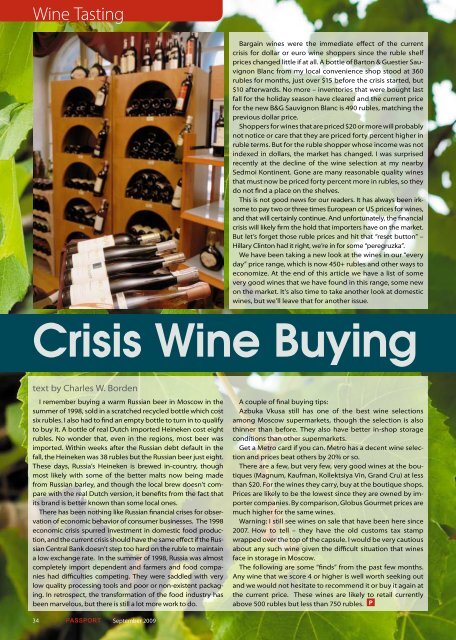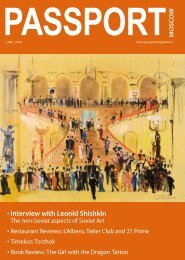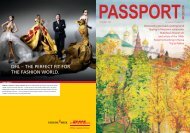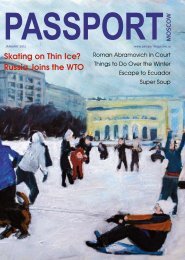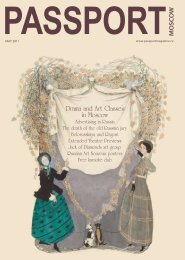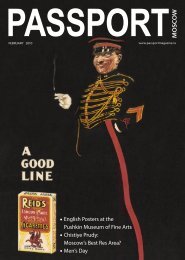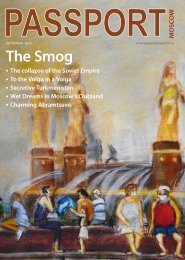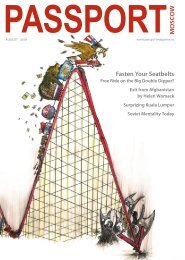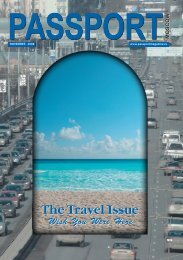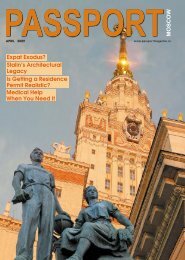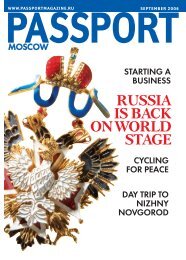Post-Perestroika Warrior - Passport magazine
Post-Perestroika Warrior - Passport magazine
Post-Perestroika Warrior - Passport magazine
Create successful ePaper yourself
Turn your PDF publications into a flip-book with our unique Google optimized e-Paper software.
Wine Tasting<br />
text by Charles W. Borden<br />
I remember buying a warm Russian beer in Moscow in the<br />
summer of 1998, sold in a scratched recycled bottle which cost<br />
six rubles. I also had to find an empty bottle to turn in to qualify<br />
to buy it. A bottle of real Dutch imported Heineken cost eight<br />
rubles. No wonder that, even in the regions, most beer was<br />
imported. Within weeks after the Russian debt default in the<br />
fall, the Heineken was 38 rubles but the Russian beer just eight.<br />
These days, Russia’s Heineken is brewed in-country, though<br />
most likely with some of the better malts now being made<br />
from Russian barley, and though the local brew doesn’t compare<br />
with the real Dutch version, it benefits from the fact that<br />
its brand is better known than some local ones.<br />
There has been nothing like Russian financial crises for observation<br />
of economic behavior of consumer businesses. The 1998<br />
economic crisis spurred investment in domestic food production,<br />
and the current crisis should have the same effect if the Russian<br />
Central Bank doesn’t step too hard on the ruble to maintain<br />
a low exchange rate. In the summer of 1998, Russia was almost<br />
completely import dependent and farmers and food companies<br />
had difficulties competing. They were saddled with very<br />
low quality processing tools and poor or non-existent packaging.<br />
In retrospect, the transformation of the food industry has<br />
been marvelous, but there is still a lot more work to do.<br />
Bargain wines were the immediate effect of the current<br />
crisis for dollar or euro wine shoppers since the ruble shelf<br />
prices changed little if at all. A bottle of Barton & Guestier Sauvignon<br />
Blanc from my local convenience shop stood at 360<br />
rubles for months, just over $15 before the crisis started, but<br />
$10 afterwards. No more – inventories that were bought last<br />
fall for the holiday season have cleared and the current price<br />
for the new B&G Sauvignon Blanc is 490 rubles, matching the<br />
previous dollar price.<br />
Shoppers for wines that are priced $20 or more will probably<br />
not notice or care that they are priced forty percent higher in<br />
ruble terms. But for the ruble shopper whose income was not<br />
indexed in dollars, the market has changed. I was surprised<br />
recently at the decline of the wine selection at my nearby<br />
Sedmoi Kontinent. Gone are many reasonable quality wines<br />
that must now be priced forty percent more in rubles, so they<br />
do not find a place on the shelves.<br />
This is not good news for our readers. It has always been irksome<br />
to pay two or three times European or US prices for wines,<br />
and that will certainly continue. And unfortunately, the financial<br />
crisis will likely firm the hold that importers have on the market.<br />
But let’s forget those ruble prices and hit that “reset button” –<br />
Hillary Clinton had it right, we’re in for some “peregruzka”.<br />
We have been taking a new look at the wines in our “every<br />
day” price range, which is now 450+ rubles and other ways to<br />
economize. At the end of this article we have a list of some<br />
very good wines that we have found in this range, some new<br />
on the market. It’s also time to take another look at domestic<br />
wines, but we’ll leave that for another issue.<br />
Crisis Wine Buying<br />
September 2009<br />
A couple of final buying tips:<br />
Azbuka Vkusa still has one of the best wine selections<br />
among Moscow supermarkets, though the selection is also<br />
thinner than before. They also have better in-shop storage<br />
conditions than other supermarkets.<br />
Get a Metro card if you can. Metro has a decent wine selection<br />
and prices beat others by 20% or so.<br />
There are a few, but very few, very good wines at the boutiques<br />
(Magnum, Kaufman, Kollektsiya Vin, Grand Cru) at less<br />
than $20. For the wines they carry, buy at the boutique shops.<br />
Prices are likely to be the lowest since they are owned by importer<br />
companies. By comparison, Globus Gourmet prices are<br />
much higher for the same wines.<br />
Warning: I still see wines on sale that have been here since<br />
2007. How to tell – they have the old customs tax stamp<br />
wrapped over the top of the capsule. I would be very cautious<br />
about any such wine given the difficult situation that wines<br />
face in storage in Moscow.<br />
The following are some “finds” from the past few months.<br />
Any wine that we score 4 or higher is well worth seeking out<br />
and we would not hesitate to recommend it or buy it again at<br />
the current price. These wines are likely to retail currently<br />
above 500 rubles but less than 750 rubles. P


